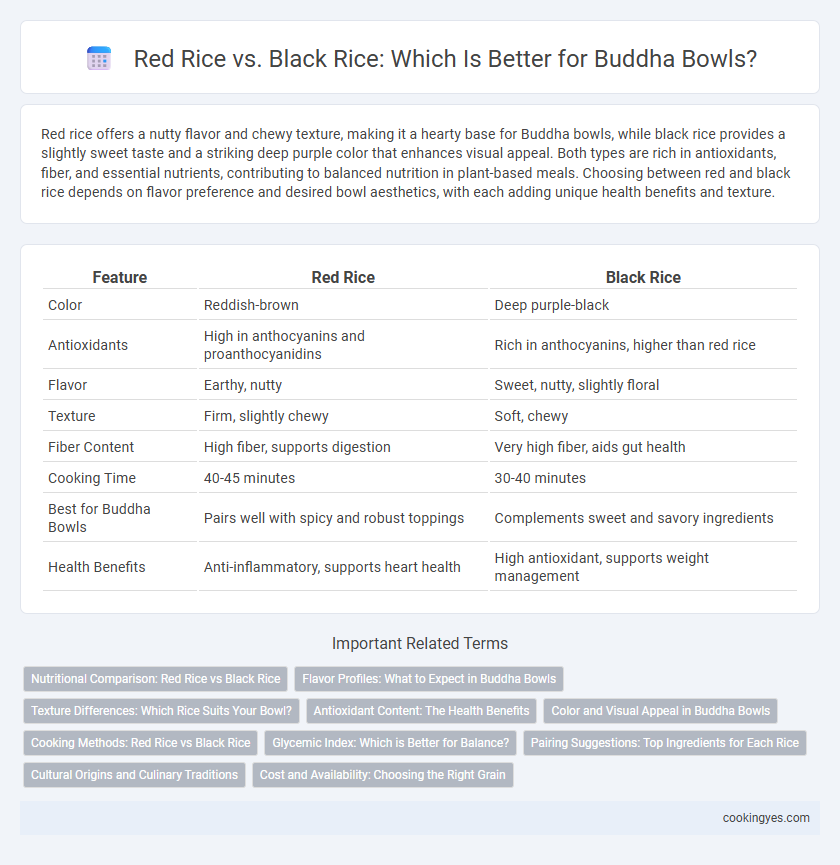Red rice offers a nutty flavor and chewy texture, making it a hearty base for Buddha bowls, while black rice provides a slightly sweet taste and a striking deep purple color that enhances visual appeal. Both types are rich in antioxidants, fiber, and essential nutrients, contributing to balanced nutrition in plant-based meals. Choosing between red and black rice depends on flavor preference and desired bowl aesthetics, with each adding unique health benefits and texture.
Table of Comparison
| Feature | Red Rice | Black Rice |
|---|---|---|
| Color | Reddish-brown | Deep purple-black |
| Antioxidants | High in anthocyanins and proanthocyanidins | Rich in anthocyanins, higher than red rice |
| Flavor | Earthy, nutty | Sweet, nutty, slightly floral |
| Texture | Firm, slightly chewy | Soft, chewy |
| Fiber Content | High fiber, supports digestion | Very high fiber, aids gut health |
| Cooking Time | 40-45 minutes | 30-40 minutes |
| Best for Buddha Bowls | Pairs well with spicy and robust toppings | Complements sweet and savory ingredients |
| Health Benefits | Anti-inflammatory, supports heart health | High antioxidant, supports weight management |
Nutritional Comparison: Red Rice vs Black Rice
Red rice contains antioxidants like anthocyanins and is rich in iron, magnesium, and fiber, supporting heart health and digestion in Buddha bowls. Black rice boasts higher levels of protein, anthocyanin antioxidants, and vitamin E, promoting anti-inflammatory benefits and improved blood circulation. Both red and black rice offer essential nutrients, but black rice provides a more significant antioxidant boost for nutrient-dense Buddha bowls.
Flavor Profiles: What to Expect in Buddha Bowls
Red rice offers a nutty, slightly earthy flavor with a chewy texture that complements the fresh vegetable and protein components in Buddha bowls, providing a robust and wholesome taste experience. Black rice, often referred to as forbidden rice, has a mildly sweet, almost berry-like flavor and a soft, slightly sticky texture that balances savory and sweet ingredients, adding depth and contrast to Buddha bowls. Both rice varieties contribute rich antioxidants and vibrant colors, enhancing the visual appeal and nutritional value of Buddha bowls.
Texture Differences: Which Rice Suits Your Bowl?
Red rice features a chewy texture with a slightly nutty flavor, adding a hearty bite to Buddha bowls. Black rice offers a tender, almost creamy texture with a subtle sweetness that complements fresh and cooked ingredients alike. Choosing between red and black rice depends on whether you prefer a firmer chew or a softer mouthfeel to balance the diverse textures in your bowl.
Antioxidant Content: The Health Benefits
Red rice and black rice both offer high antioxidant content, with black rice containing more anthocyanins that provide stronger anti-inflammatory and heart health benefits. Red rice is rich in proanthocyanidins, which support immune function and reduce oxidative stress. Incorporating either grain into Buddha bowls enhances nutrient density and promotes cellular health.
Color and Visual Appeal in Buddha Bowls
Red rice offers a rich, earthy hue that adds warmth and depth to Buddha bowls, enhancing their visual appeal with its vibrant rust color. Black rice provides a striking contrast with its deep purple-black grains, creating a dramatic and elegant look that highlights the dish's freshness. Combining red and black rice elevates the bowl's aesthetic by delivering a colorful and visually engaging presentation, perfect for nutrient-dense, Instagram-worthy meals.
Cooking Methods: Red Rice vs Black Rice
Red rice requires a longer cooking time, typically 30 to 40 minutes, due to its dense bran layer which enhances its nutty flavor and chewy texture, making it ideal for hearty Buddha bowls. Black rice cooks slightly faster, around 25 to 30 minutes, and becomes tender with a subtle sweetness that adds a striking visual contrast and nutritional boost to Buddha bowls. Both rice varieties benefit from soaking to reduce cooking time and improve texture, with black rice soaking particularly effective in retaining its antioxidants and vibrant color.
Glycemic Index: Which is Better for Balance?
Red rice has a glycemic index (GI) ranging from 55 to 65, offering moderate blood sugar control, while black rice typically has a lower GI between 42 and 50, making it a better option for stabilizing blood glucose levels. Black rice is rich in anthocyanins and fiber, which contribute to slower carbohydrate absorption and better glycemic balance. Incorporating black rice into Buddha bowls supports sustained energy release and improved metabolic health compared to red rice.
Pairing Suggestions: Top Ingredients for Each Rice
Red rice pairs exceptionally well with roasted vegetables, grilled chicken, and spicy chickpeas, enhancing Buddha bowls with its nutty flavor and chewy texture. Black rice complements creamy avocado, mango slices, and crunchy toasted nuts, offering a visually striking contrast and a slightly sweet taste. Both rice varieties benefit from fresh herbs like cilantro or basil and a drizzle of citrusy dressing to balance their rich flavors.
Cultural Origins and Culinary Traditions
Red rice, with origins in Bhutan and southern India, boasts a nutty flavor and is traditionally used in Southeast Asian and Himalayan cuisine, often paired with spicy and savory Buddha bowl ingredients. Black rice, known as forbidden rice in ancient China, carries a slightly sweet, earthy taste and is revered in East Asian culinary traditions for its health benefits and rich antioxidants. Both varieties offer unique textures and colors that reflect their cultural heritage while enhancing the visual appeal and nutritional profile of Buddha bowls.
Cost and Availability: Choosing the Right Grain
Red rice is generally more affordable and widely available in supermarkets, making it a cost-effective choice for Buddha bowls. Black rice, often considered a specialty grain, tends to be pricier and found in health food stores or online. Budget-conscious consumers seeking whole grain options will find red rice easier to source and more economical for regular meal preparation.
Red Rice vs Black Rice for Buddha Bowls Infographic

 cookingyes.com
cookingyes.com